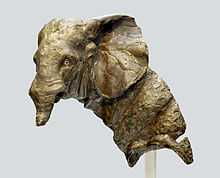North African elephant
| North African elephant | |
|---|---|
 | |
| Roman mosaic at Ostia Antica, Italy | |
| Conservation status | |
| Scientific classification | |
| Kingdom: | Animalia |
| Phylum: | Chordata |
| Class: | Mammalia |
| Order: | Proboscidea |
| Family: | Elephantidae |
| Genus: | Loxodonta |
| Species: | L. africana |
| Subspecies: | L. a. pharaoensis |
| Trinomial name | |
| Loxodonta africana pharaoensis | |
The North African elephant (Loxodonta africana pharaoensis) was the subspecies of the African bush elephant (Loxodonta africana), or possibly a separate elephant species, that existed in North Africa north of the Sahara until becoming extinct in Ancient Roman times. These were the famous war elephants used by Carthage in the Punic Wars, their conflict with the Roman Republic. Although the subspecies has been formally described,[1][2] it has not been widely recognized by taxonomists. Other names for this animal include the North African forest elephant, Carthaginian elephant, and Atlas elephant. Originally, its natural range probably extended across North Africa and down to the present Sudanese and Eritrean coasts.
Description

Carthaginian frescoes[3] and coins minted by whoever controlled North Africa at various times show very small (perhaps 2.5 metres or 8 feet 2 inches at the shoulder) elephants with the large ears and concave back typical of modern Loxodonta. The North African elephant was smaller than the modern African bush elephant (L. a. africana), probably similar in size to the modern African forest elephant (L. cyclotis). It is also possible that it was more docile than the African bush elephant, which is generally untamable, allowing the Carthaginians to tame it by a method now lost to history. Modern scholarship has disputed whether or not Carthaginian elephants were furnished with turrets in combat; despite assertions to the contrary, the evidence indicates that African forest elephants could and did carry turrets in certain military contexts.[4]
History
After they conquered Sicily in 242 BC, the Romans wanted to capture some specimens that had been left behind in the middle of the island by the Carthaginians, but failed in the endeavor. The elephants with which Hannibal crossed the Pyrenees and the Alps in order to invade Italy during the Second Punic War (218-201 BC) belonged to this group, with the exception of Hannibal's personal animal, Surus (meaning "the Syrian," or possibly "One-Tusker"[5]). This individual, according to his documented name and large size, may have been a specimen of the huge westernmost subspecies (Elephas maximus asurus) of the Asian elephant, also now extinct.
The North African elephant was also trained and used by the Ptolemaic dynasty of Egypt. Writing in the 2nd century BC, Polybius (The Histories; 5.84) described their inferiority in battle against the larger Indian elephants used by the Seleucid kings. A surviving Ptolemaic inscription enumerates three types of war elephant, the "Troglodytic" (probably Libyan), the "Ethiopian", and the "Indian". The Ptolemaic king prides himself with being the first to tame the Ethiopian elephants, a stock which could be identical to one of the two extant African species.
It is believed that L. a. pharaonensis must have become extinct some decades after the Roman conquest of North Africa (perhaps in the 2nd century BC), due to overhunting for use in venatio games. Some authorities believe that small populations may have survived along the Sudanese and Eritrean coasts until the mid-19th century, but if so, these are now certainly extinct.
Taxonomic uncertainty
Given the relatively recent date of its disappearance, the status of this population can probably be resolved through ancient DNA sequence analyses, if specimens of definite North African origin are located and examined.
See also
- Syrian elephant, a subspecies of Asian elephant that became extinct around 100 BC.
References
- ↑ Nowak, Ronald M. (1999), Walker's Mammals of the World, 6th edition, Baltimore and London: The Johns Hopkins University Press, pp 1002.
- ↑ Yalden, D.W., M.J. Largen and D. Kock (1986), Catalogue of the Mammals of Ethiopia. 6. Perissodactyla, Proboscidea, Hyracoidea, Lagomorpha, Tubulidentata, Sirenia, and Cetacea, Italian J. Zool., Suppl., n.s., 21:31-103.
- ↑ tunisie : Tunisie, Carthage, la ville disparue
- ↑ Rance, P. (2009). "Hannibal, Elephants and Turrets in Suda Θ 438 [Polybius Fr. 162B] – An Unidentified Fragment of Diodorus". Classical Quarterly 59 (1): 91–111. doi:10.1017/S000983880900007X.
- ↑ Scullard, H. H. (1953). "Ennius, Cato, and Surus". The Classical Review 3 (3/4): 140–142. doi:10.1017/S0009840X00995805. JSTOR 703426.
